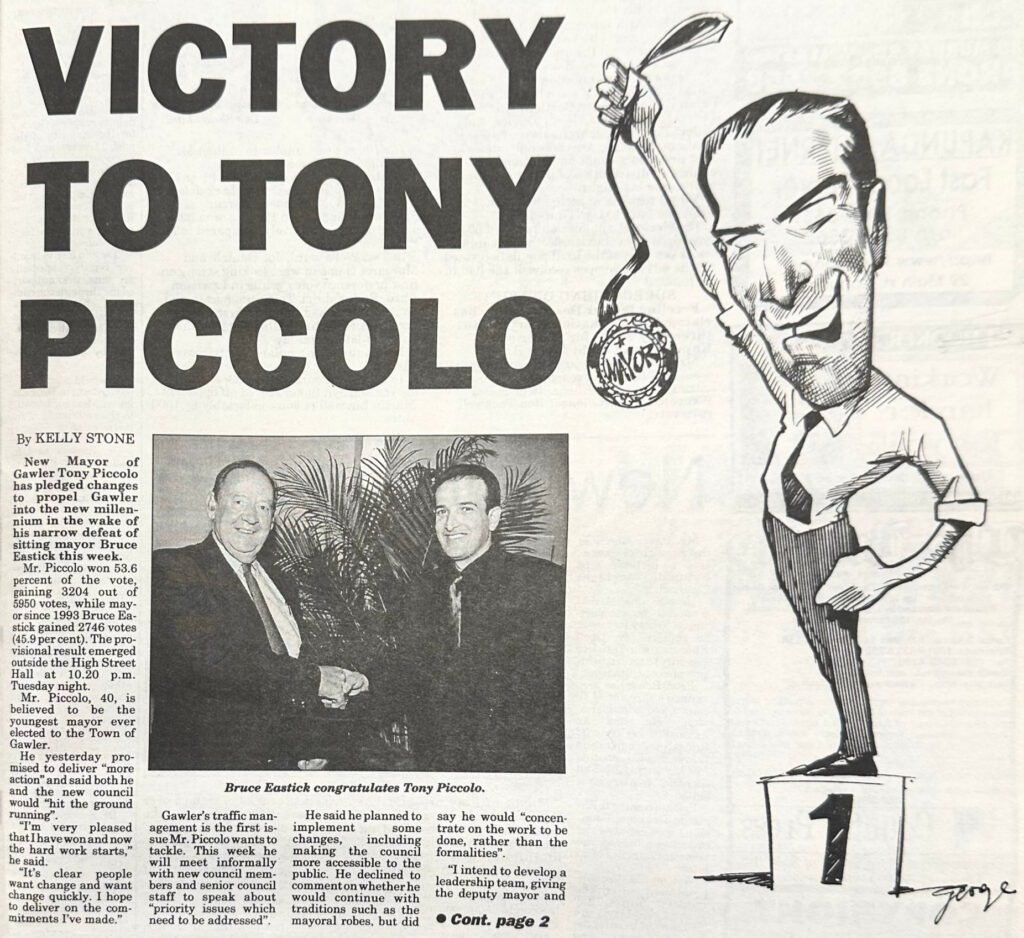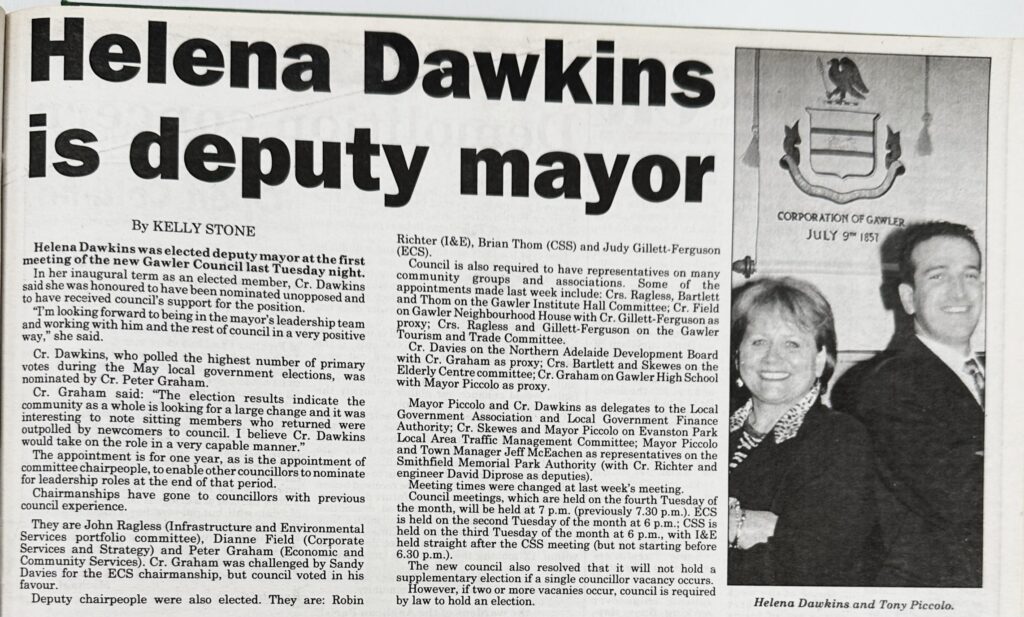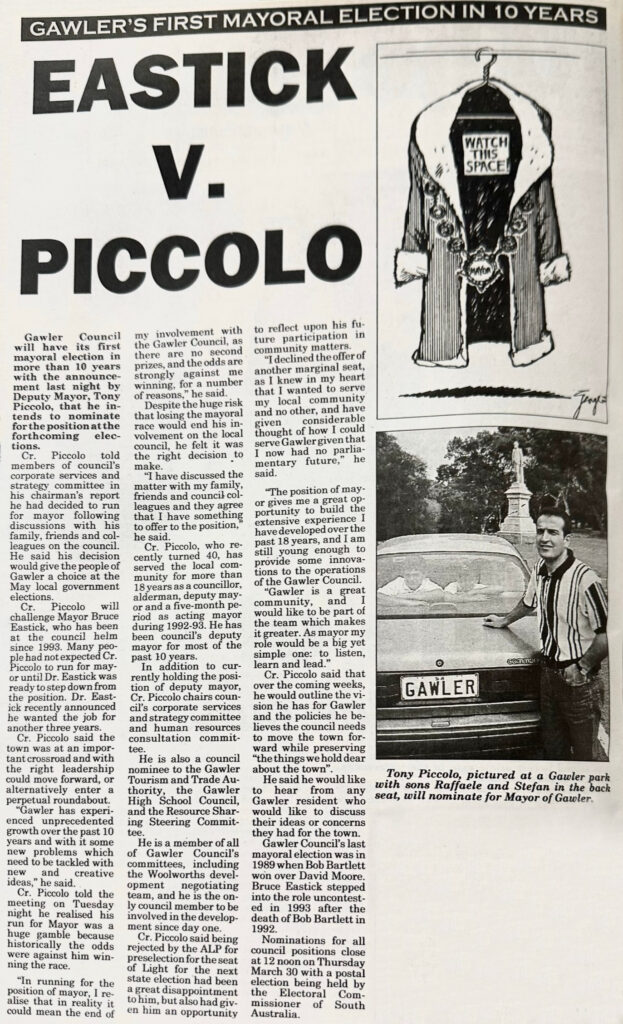Here we come to a major turning point election for Gawler. I’m not speaking just from a historical perspective; judging by the massive (for Council standards) turnout rate of 46%, the people of Gawler thought so too.
This was the first election after the abolition of the Gawler Council ward system, so as we continue into the past, Councillors will be elected in wards rather than one big pile as we have seen up until now.
Now, let’s meet the Mayoral contestants.
The incumbent: Dr Bruce Eastick AM
Dr Bruce Eastick had initially been Mayor of Gawler from 1968-1972, and returned to the role of Mayor in 1993. This was a long time between terms, but there were no gaps in his political resume; he had spent the intervening time as the local Member of Parliament for the electorate of Light.
In 1996, he was made a Member of the Order of Australia (AM), for his “service to the South Australian Parliament, local government and the community”.

The Bunyip, March 8th, 2000.
(The picture of the dog is entirely unrelated, but I left it in because the combination of the photo and headline made me laugh. Coincidentally, the “Dr” in Dr Bruce Eastick does also happen to be due to his status as a qualified veterinarian, but it’s not him in the photo.)
Bruce Eastick was first elected to Gawler Council in 1963 (37 years prior to this election) and was a Ward Councillor for five years before becoming Mayor. He was a member of the Liberal Party (or as it was called at the time, the Liberal and Country League), and was elected as the Member of Parliament for Light in 1970 while continuing his role as Mayor. This was allowed at the time, but is no longer possible under South Australian law.
Eastick resigned as Mayor after taking up new responsibility as the Leader of the Opposition in 1972. Over his 23-year term as Member for Light, he also held other roles in Parliament, such as Speaker of the House.
After Mayor Bob Bartlett died in late 1992, Bruce Eastick ran for the position of Mayor unopposed at the 1993 elections, leading to another brief period of wearing two hats as both the Mayor and local Member of Parliament (until his term as MP expired that December).
Bruce Eastick had not been challenged even once since resuming his seat as Mayor at the 1993 elections, but that was all about to change.
The challenger: Deputy Mayor Tony Piccolo
The Bunyip, March 22nd, 2000.
Tony Piccolo was first elected in 1981 (at the age of 21), to the Evanston Ward of Munno Para Council. By 1985, however, boundary changes had moved this area into the Gawler Council. When the 1985 election came around, he successfully made the transition to the new Council.
For most years between 1989 and 2000, he also served as Gawler’s Deputy Mayor. In 1992, when Mayor Bob Bartlett died in office, Tony Piccolo became the acting Mayor in the lead-up to the 1993 election, which was the election in which Bruce Eastick stepped into the position unopposed.
While the two had never competed in a Council election, this was actually the third time that Tony Piccolo and Bruce Eastick had gone head-to-head. In both 1985 and 1989, while Eastick was the State Member of Parliament for Light, representing the Liberal Party, Piccolo was the representative of the Labor Party for the seat.
At the time, Light was a consistently Liberal seat that hadn’t seen a Labor MP since the days of World War II, over 40 years prior. Eastick won the 1985 election, taking 59% to Piccolo’s 41% in the two-party-preferred vote count, and then won the 1989 election with an increased margin of 63% to 37% (reflecting overall swings across the state).
In fact, by 2000 Tony Piccolo was now looking to get back into running at the state level; the electorate of Light had shifted further south into the Labor-leaning metropolitan area and was now considered a marginal seat. That’s the point in this story when we need to talk about:
The Annette Hurley Situation
This came up several times as I was looking through editions of The Bunyip from this time period. Messages like this were showing up in the Bunyip’s Letter to the Editor section:

The Bunyip, February 2nd, 2000.
Annette Hurley was the Deputy Leader of the South Australian Labor Party and an incumbent MP in the much safer nearby seat of Napier. If Labor won the upcoming election, she was poised to become the first female Deputy Premier in the state’s history.
With the electorate of Light hovering only a couple of percentage points from a Labor victory, it was thought that an experienced MP with some star power might be just what would push the seat over the edge. This (and no doubt also some factional internal reasoning) led to Annette Hurley being pre-selected to run as Labor’s candidate in Light.
To the Labor Party, this was a courageous and risky act from a loyal party member, worthy of reward; when she later failed to win the seat at the election, she was only out of office for a couple of years before being placed in a safe spot on the Labor Senate ticket at the 2004 Federal Election. She was successfully elected and served a six-year term in the Senate.
To Tony Piccolo, though, this was clearly a source of discontent. To quote him from his campaign launch article that I shared earlier, “I have given considerable thought of how I could serve Gawler given that I now had no parliamentary future”. He said that he had been offered a different marginal seat but had declined because he wanted to represent Gawler.
Looking back in retrospect, we know that Hurley would fail to take the seat and Piccolo would then become the MP in 2006, where he remains to this day. At the time, though, it looked to be a missed opportunity for Tony Piccolo for potentially another entire generation – if Annette Hurley took the seat, she would likely stay there for future elections too.
And so, Tony Piccolo took the plunge and challenged the incumbent Mayor of Gawler for that position. The last time there had even been a Mayoral election was in 1989, 11 years prior, and it had been between two fresh candidates after the incumbent Mayor had stepped down.
The battle was on.

The Bunyip, May 3rd, 2000.
The Mayoral Election Results

The Bunyip, May 18th, 2000.

Tony Piccolo had won, gaining 54% of the vote to Bruce Eastick’s 46%. Eastick would not run for election again and would retire after these 37 consecutive years in public office.
The voter turnout here is the highest I’ve covered for a Gawler Council election so far, at 45.9%. At the time, the Electoral Commission reported Gawler as having 13,606 electors on the roll, of which 6235 returned their ballot packs (the elections I’ve covered so far have all been via postal vote).
There are two main explanations to offer for the peak turnout here. The first is simply the candidates; it’s obvious that two veteran campaigners with decades of elections behind them would be able to turn out residents to vote.
The second is that, in general, voting percentages in Gawler have been consistently declining as it has gotten larger and more metropolitan. Every election for the next 18 years would have a lower turnout than the last – after 45.9% in 2000, we would get 41.5% in 2003, 34.2% in 2006, 33.7% in 2010, 30.4% in 2014, and 28.7% in 2018. The 2022 result of 34.4% was an anomaly in that respect; it was the best turnout we had seen since 2003.
This is not something unique to Gawler, but a consistent find across all South Australian Councils. Generally speaking, the more rural the area, the higher the turnout. It makes sense – in a more regional area, the jobs and schools and customers etc are all part of the same ecosystem of people who know each other.
In contrast, many people in metropolitan areas will sleep in one Council area, work in another, and then pop over to a third for dinner. Not to say that they won’t engage in any local activities or community groups, but their name recognition of local figures is generally going to be lower. For people living as part of a greater “city”, their response to seeing a list of local candidates for Council will often be “Who are any of these people?”
Gawler’s population may have increased from around 13,000 voters to around 19,000 in the 2022 election, but that 13,000 number reflected people who had been living here a long time in a “country town”, whereas the modern 19,000 reflects a lot of new residents who have moved into “dormitory suburbs” at the edge of the metro area. This inevitably results in a lower turnout at Council elections.
That said, I do hope that we can continue to engage people into thinking of Gawler as their local community as this entire region prepares for massive growth over the upcoming decades.
The Councillor Elections
This was an interesting transition point for Councillors because the year 2000 represented the first Area Councillor elections. While there are a few historical cases of Area Councillors (known as “Aldermen”) that had existed alongside Ward Councillors, the Town of Gawler had always had wards since its creation in 1857.
This meant that while many incumbent Councillors may have had geographic pockets of support in their own ward, they were also likely to be lesser known in the other (at the time) five wards. Also, the number of Councillor spots had been reduced from twelve to ten at this election. How candidates would perform in one big election pile across the Council area was anybody’s guess.
Eighteen candidates ran for the ten positions. As always, here’s a spread with all of their profiles:


The Bunyip, May 3rd, 2020.
The incumbent Council had twelve members, of which eight had re-nominated. The remaining four were: Andrew Philpott, Michael Johnson, and Paul Little, who had declined to run (though Little would return 18 years later), and Tony Piccolo, who ran for Mayor instead.
The Councillor Election Results

The Bunyip, May 24th, 2000.

This is the last time we will be seeing our friends at the Electoral Commission of South Australia and their helpful election statistics, as this was the first Council election cycle to be run by an overarching body.
Prior to 2000, it seems that individual Councils all ran their own elections, with the CEO/Town Manager often functioning as the returning officer and then reporting the results back to the State Government.
Election results won’t disappear going forward, but small details like the preference count flows may become harder to find. In the future, we’ll be relying on a) what the Bunyip reports and b) what the Gawler Council officially reports to the State Government Gazette.
So, let’s take a look at these results. In order of election, the 2000-2003 Council is:
- Helena Dawkins (new) – winner of this year’s Top of the Ballot Bonus.
- Ian Skewes (new)
- Rob Richter (new)
- Judy Gillet-Ferguson (new)
- Brian Thom (new)
- Lillian Bartlett (incumbent)
- Sandy Davies (incumbent)
- Dianne Field (incumbent)
- John Ragless (incumbent)
- Peter Graham (incumbent)
There are some very obvious trends here. It’s unusual for the first-time candidates to all rank in the top five together; this is probably at least partially a reflection of the incumbent Councillors’ advantage being limited here due to the switch from a ward system. It may also just reflect a high turnout and a mood for change among voters.
In fact, this explanation was cited directly when Helena Dawkins was later nominated directly for Deputy Mayor at her first Council meeting.

The Bunyip, June 7th, 2000.
This support for her as Deputy Mayor would continue across two Council terms, culminating in Councillors internally electing her as Mayor after the resignation of Tony Piccolo in 2006.
Incumbent Councillors who missed out were Patsy Kellett (who finished 11th), Yvonne Davison, and Roland Chatterton. There was also former Councillor Warren Dibben, who had failed at both 1997 and 2000 to reclaim his seat, but whose persistence would pay off when he returned from 2003-2010.
Here is an official group shot of the 2000-2003 Council (the Bunyip wasn’t doing much colour in 2000 so this is the one colour photo we’ll get):

Back row: David Diprose (staff), Cr Brian Thom, Cr John Ragless, Cr Robin Richter, Cr Ian Skewes, Cr Peter Graham, Jeff McEachen (CEO)
Front row: Sue Carter (staff), Cr Lillian Bartlett, Deputy Mayor Helena Dawkins, Mayor Tony Piccolo, Cr Dianne Field, Cr Judy Gillett-Ferguson, and Cr Sandy Davies.
This 6-5 male/female split is also the highest ratio of women on any Gawler Council thus far. In fact, this seems to be the peak time period for gender balance on Council; the prior 1997 group also had five women (though it was an 8-5 split in that case because there were more Councillors) and the 1995 batch before that had four, but I can’t find any other election either before or since that’s had more than three women on Council.
Please turn your phones to silent
I just wanted to highlight this particular article, about a Council motion which seems to have been put up mostly because other Councillors were annoyed that Cr Peter Graham wouldn’t put his mobile phone on silent. “We’re here to make important decisions and it’s rare for us to have a meeting that’s not interrupted by the William Tell Overture”, said Cr Sandy Davies (no relation).

The Bunyip, February 9th, 2000.
Twenty-two years later and a candidate’s phone would go off during 2022’s Meet the Candidates forum. Truly a recurring problem in this modern age of ours.
Meanwhile, in Kudla

The Bunyip, February 2nd, 2000.
As always, here’s Gawler’s longest-running continuously unresolved saga, which this will not be the last post about. There are other issues that keep coming back up throughout Gawler’s history (wait until you see how long people have been complaining about the state of our main street), but this one simply never went away in the first place – it’s a lot of the same names in the letters to the editor now as then.
That’s it for now, but look forward to my next post, in which we’ll enter a completely different world. As we reach 1997, we will depart from Gawler Council’s brief run of Area Councillor elections and settle into its default state for most of its history – ward elections.

Pingback: 1997 in Gawler's Election History - Cody Davies - Town of Gawler Elected Member
Pingback: 1995 in Gawler's Election History - Cody Davies - Town of Gawler Elected Member
Pingback: 1985 in Gawler's Election History - Cody Davies - Town of Gawler Elected Member